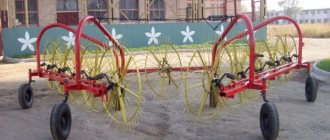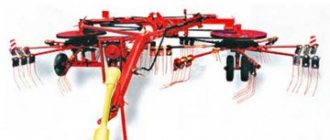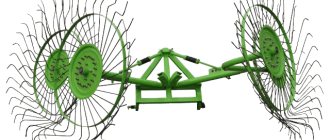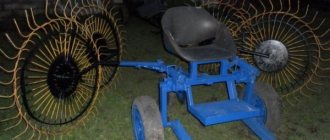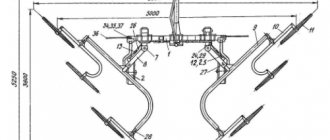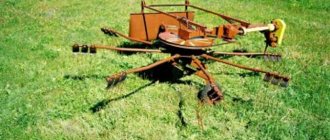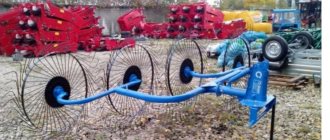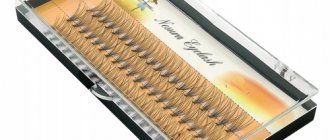The GVR-6 rake-tedder, which will be discussed in the article, is used for raking grass. Next comes the process of forming windrows at a grass moisture content of no more than 70%. The design is used:
- on sown hayfields;
- also on natural hayfields.
The equipment can work on the ground with an inclination in the direction of movement of the equipment not exceeding 5 degrees. For the process of accelerating the drying of grass and obtaining high-quality hay, GVR-6 is ideally suited.
Wheeled finger tedder GKP 5: technical characteristics, price, reviews, video.
Mower conditioner rotary gearbox 2.4V here.
Technical characteristics of tedders (GVR - 6)
Rotary models are used in agriculture when processing mown grass.
The trailed structure covers the surface of the treated area of 6 meters. The operating efficiency of this unit is 7 hectares of field for 1 hour. The structure, weighing 1000 kg in working condition, has dimensions that differ from those in the state of transportation to the field work site. A speed of 20 km/h is recommended when traveling.
Fields are processed at a speed of 12 km/h. This speed does not affect the quality of the processed hayfield. To dry and spread herbs, use a pair of rotors with eight rods. Factory production has provided a 3-tooth arrangement on each rod for a strong connection.
The mower model does not move without the help of a wheeled tractor; it works through a hydraulic system
Wide sized design, utmost attention of the tractor driver is required for safe use
To compensate for the loads that arise during movement, springy units for long-term use are installed. The design of the system is designed for effective operation in fields with complex soil surfaces.
The trailer interacts with wheeled tractors. Maintenance of tedders is carried out by one operator to process swaths in the fields. (GVR - 6) will not cope with wet grass, the humidity of which reaches 85%; there are other models for tasks of this kind.
Device (GVR - 6)
The unit for drying and folding hay consists of a special rake for collecting swaths into windrows, tedding and pressing dry grass and straw.
- The mower consists of two rotors, the arrangement is horizontal in accordance with the area being processed.
- The equipment is equipped with support wheels.
- The frame is made of high quality metal, ensuring durability.
- Tow hitch and drive mechanism.
The rotor device consists of a long rake, a treadmill and a mechanism that drives the system. Timely maintenance and replacement of worn-out but not yet failed parts will increase the operating efficiency of this unit. Any technical device requires constant technical inspection.
Operating principle and adjustment (GVR - 6)
Operation (GVR-6) begins with preparatory work.
- First, attach the rake trailer to the crossbar of the tractor and secure it.
- When attaching the safety cable to the crossbar of the tractor, it is necessary to hook the rake onto the spoke.
- We attach the cardan shaft to the vehicle.
- Don't forget to connect the rake's hydraulic system to the tractor system.
Having brought the unit into working position, you can go to process the hayfield. Using the adjustment lever, we raise the rake system and move to the processing site. The adjustment lever makes it possible to lower the wheels in case of poor grip of grass from the field surface or raise them when gripping the ground.
Catalog of spare parts with diagrams and numbers - download / read PDF
The rake's fingers pick up the grass as it moves. The grip occurs from the bottom of the base in the middle part, the fingers release the hay. The mass of dry grass is constantly in motion, passing the length from wheel to wheel until reaching the last one, creating a windrow. Loose grass is quickly dried when blown by the wind.
By changing the position of the treadmill, the direction of ejection of the grass mass changes accordingly. Rotation to a horizontal position results in the creation of windrows. When passing through the windrow, the opposite action occurs again, scattering the wet hay to dry.
The width of the swath is adjusted using stretchers. For tedding, the implement section requires minor modifications. The grass mass will not pass from wheel to wheel, it will simply remain on the field. The movement of the section along the roll results in wrapping and shearing.
Rakes - tedders GVR - 6 user reviews
Owners of auxiliary agricultural equipment note the efficiency of tedding and the quality of the resulting final product. They talk about good speed performance that does not affect the final result.
The wheel travel with soft tires provides good shock absorption when moving the tedder. Not difficult to manage. Low-cost in technical and repair terms.
Harvester for sunflower harvesting: price, reviews, video, description.
Read about the model range of New Holland combines here.
John Deere combines, their types and descriptions, read this article.
Design and classification of tractor rakes
Structurally, tractor rakes are working elements mounted on a metal frame, designed for raking and tedding hay.
The working elements are driven by the power take-off device of the traction machine or work when their own wheels rotate.
The position of the frame frame of trailed-type devices is changed by adjusting the drive wheel. Mounted rake systems are raised and lowered by hydraulic drives connected to the hydraulic circuit of the base tractor.
Aggregation of devices with tractors, including MTZ machines, is carried out using a trailing mechanism (trailer units) and a linkage of the base machine (mounted rakes).
Based on the number of sections of working bodies, rake units are divided into multi-section units used to perform a large volume of work and single-section devices for processing small areas.
Depending on the shape of the working bodies and the principle of their operation, rake units are divided into:
- Transverse, forming a roll located perpendicular to the direction of movement of the base chassis, units with a different number of sections and variable working width. Machines of this type are equipped with sections of working elements that fold during transportation and have cylindrical teeth mounted on hinges. When performing work, the transverse type rake mechanism copies the soil surface of the treated area.
- Wheel-finger rake, consisting of identical independently operating sections symmetrically located in the left and right parts of the frame. Each section consists of working bodies made in the form of a wheel with metal fingers and support pneumatic wheels. Units of this type are used both for raking grass into windrows and for tedding it during dry mowing.
- Rotary rake complexes are devices with the greatest functionality with automatically changing the working width and the height of the working parts, designed for raking, tedding grass and haylage and placing them in windrows. During operation, the unit uses rotary working elements with cylindrical teeth mounted on the frame.
Design of GVR tractor rakes
The equipment is of the wheel-finger type. Consists of two horizontal rotors and is equipped with support wheels. The rotor includes:
- long rakes (with 32 fingers each);
- treadmill;
- drive unit.
The supporting frame is welded from durable steel. The design ensures not only the movement of hay, but also allows it to be evenly raked from both sides into a neat windrow. As a result, the device performs four functions simultaneously:
- rakes hay into windrows;
- stirs it up, which speeds up drying and prevents rotting;
- if necessary, dismantles finished rolls;
- collects and compacts dried hay (a rake is provided for this purpose).
The GVR 6 rake performs several functions.
The GVR 630 rotary tedder rake is designed for raking and tedding of grass. It is especially important for the Russian climate that they cope with grass with a humidity of up to 70%. They can be used after light rain or in wet weather to protect wet grass from rotting. In addition, regular tedding significantly speeds up the drying process and improves the quality of hay. However, the tedder will not cope with wet grass after a rainstorm; in this case, you will need to use special models.
This type of equipment is recommended for use on high-yielding, both seeded and natural hayfields. Suitable for use on slopes up to 5° (in the direction perpendicular to the movement).
Device and purpose
Tedder rakes replaced conventional rakes, which were used for raking grass after mowing. With their advent, it was possible to mechanize the process of making hay and completely eliminate the use of heavy manual labor. Structurally, the rake-tedder is a two-section wheel-finger design, in which the sections can work both together and separately. Each unit consists of a frame, support wheels and rotating rotors, which are the main working parts of the unit. The rotors are attached to the frame using tapered bearings, and the torque required for their rotation is transmitted using the driveshaft of the tractor. The support wheels move due to adhesion to the ground while the tractor is moving.
Each of the rotors is equipped with raking fingers, which are made from high-strength steel. Depending on the model, the number of rotor fingers can be different - from 32 to 48 pieces. The rotor wheels are secured using a spring suspension, which prevents mechanical damage to the working elements and extends the service life of the unit. The rotors are located at a certain angle in relation to the line of movement of the tractor, and thanks to a rotating adjustment lever, they can be raised or lowered to the desired height for more efficient operation. The same lever is used to switch the unit to transport mode, when the rotors are raised high above the ground so as not to be damaged during movement.
Price
The new unit will cost the buyer 75-80 thousand rubles, depending on the region. The lowest prices are in Ryazan and Chelyabinsk, the closer to Moscow and the region, the more expensive. Used ones can be purchased for 50 thousand or less. Don't be afraid of low prices for used rakes. As mentioned above, even a serious breakdown can be dealt with by yourself by returning the device to its working position.
The domestic manufacturer has proven by its own example that our technologies can well compete with Western developments. Simplicity and reliability are what lies at the heart of the GVK-6. For entrepreneurs and farmers who value their time and money, this is a must-have purchase.
User manual
When working with rakes, a number of recommendations should be followed.
- The equipment should be mounted with the tractor engine turned off.
- Before starting work, it is necessary to check the connection of the rake and the tractor, as well as the presence of a safety cable attached to the crossbar of the tractor. You also need to make sure that the hydraulic system is tight and that the driveshaft is in good condition.
- When stopping, the gear lever must be placed in neutral and the power take-off shaft (PTO) must be disconnected.
- It is prohibited to leave the tractor unattended with the engine and PTO turned on, as well as with the parking brake turned off.
- Adjustment, cleaning and maintenance of the rake-tedder should only be done with the tractor engine switched off.
- On turns and difficult terrain, the speed of the rake should be reduced to a minimum, and during particularly sharp turns it is necessary to disengage the PTO.
To see how rakes and tedders work, see the following video.
Let's block ads! (Why?)
Application of tedder rakes
After mowing, you should prepare the grass for turning it into hay. This means that it is necessary to form windrows, turn over from time to time, and collect into bales or rolls. Factory or homemade tedder rakes collect the mown grass into windrows and, if necessary, turn them over to dry. To use hay harvesting equipment, walk-behind tractors, mini tractors, tractors and even horses are used. This is much more efficient than working with hand tools. You can perform the following operations:
- raking of mown plant matter;
- tedding the grass;
- windrow wrapping and spreading;
- doubling of arranged rows of rolls.
Do-it-yourself rakes for mini tractors have a number of advantages. The device is more efficient than hand tools, is easily transported to the storage area and takes up little space. Affordable price and no problems purchasing spare parts.
Rotary rake-tedder GVR-420, GVR-630 design and purpose
Rotary rake-tedder GVR-420, GVR-630 design and purpose
The GVR-630 rake-tedder is used to perform operations of raking dried/freshly cut grass into windrows, tedding grass in swaths, doubling, wrapping and scattering windrows.
The design of the GVR-630 rake-tedder is equipped with two rotors rotating in one direction. Thanks to the increased number of rakes, high-quality execution of the technological process is ensured, and losses become minimal. Reducing losses of harvested material is also ensured by excellent terrain following, which is guaranteed by the small diameter of the rotors and the possibility of their vertical oscillation. It is permissible to use this machine near obstacles to throw the mown mass away from them. The use of a simple and reliable drive in the design of the GVR-630 rake-tedder ensures the reliability of the unit during the working process. For the convenience of transporting the GVR-630 rake-tedder along public roads, the rake can be easily removed and installed in special nests. This unit is suitable for tedding swaths with a seventy percent moisture content, for wrapping and spreading windrows when they get wet, which helps speed up the process of natural drying of grass and produce high-quality hay.
An important distinctive feature of the GVR-630 rake-tedder is its high versatility, which consists in the ability to perform 6 technological operations, namely: tedding of windrows, tedding of swaths, doubling of windrows with a shuttle, wrapping of windrows, raking of windrows, doubling of windrows. The ease and speed of transferring the unit to perform any operation is ensured by the control system.
Technical and operational characteristics of the rake-tedder GVR-630:
| Productivity indicator, ha/h | 7,0 |
| Working width, m | 6,3 |
| Number of rotors, pcs. | 2 |
| Speed during operation does not exceed, km/h | 12,0 |
| Unit dimensions, m, length/width/height, | 4,2/6,4/1,4 |
| Unit weight, kg | 1100 |
| For aggregation, tractors are used, class. t.s. | 1,4 |
| Type of tractor towing device | TSU-1Zh |
Rotary rake-tedder GVR-630
Designed for raking grass from swaths into windrows, tedding it in swaths, wrapping, scattering and doubling the windrows. The main advantages of the design of the GVR-630 rake are: the versatility of the machine, the ability to perform several operations - scraping, tedding, turning windrows, scattering them, as well as doubling, which creates conditions for greater productivity of harvesting machines in subsequent operations; the windrow formed by GVR-630 is uniform and fluffy, which creates conditions for greater productivity of machines in the selection of windrows, since they do not need to process heaps of hay, which, as a rule, form wheel-finger and transverse rakes; simpler and faster transfer from transport to working position; the ability to work efficiently at high speeds (up to 12 km/h), with a maximum productivity of 7 hectares per hour of main work. The productivity of balers harvesting windrows formed by GVR-630 increases up to 28% in comparison with the work of picking up windrows formed by wheel-finger rakes, after which the pick-up and receiving chamber are often clogged, which is why the safety pins are cut off. V-belt drives were introduced into the transmission of the GVR-630 rake. They transmit rotation to the rotors and at the same time serve as a damping element of the transmission, which increases the durability of the agricultural machinery drive.
Manufacturers and modifications of rake-tedders "GVK-6"
At this time, the GVK-6 rake-tedder is manufactured at the FKU IK-2 enterprise, at the correctional colony No. 2 of the city of Ryazan (Voroshilovka village, district). The trade name has recently been changed to “rakes-tedders “GVV-6 “Katyusha”. This is a lightweight version of the tedder rake. It is distinguished by more compact dimensions and lighter weight than the modernized modification “GVK-6M”, which is currently produced by the Sol-Iletsk Machine-Building Plant).
Rake-tedder in transport position.
This enterprise is located in the city of Sol-Iletsk, Orenburg region. From its very foundation, in 1944, until the present era, it has specialized in the production of trailed hay harvesting equipment. In addition to this, it also produces tractor trailers. The largest distributor of the GVK-6M trailed unit is the international association BelAgro. It includes 34 branches - large centers for the sale of agricultural machinery and spare parts for it, as well as service centers, located in Belarus, Ukraine, Russia and Kazakhstan.
Price analysis of tedder rakes
You can order and purchase a model (GVR - 6) for processing haymaking in the online store. Buying these products directly from the manufacturer is beneficial for the user. The design undergoes pre-sale preparation, paperwork, technical passport first.
Anyone who has the conditions for self-assembly can read how to make a tedder rake with your own hands
Estimated price ranges from 140,000.00 to 147,000.00 rubles. There are offers to purchase the unit on secondary markets; these are used models. Many structures are in excellent condition and can work for many years to come, with proper technical inspection. The cost of used units ranges from 78,500.00 to 112,456.00 rubles.
Buyers are provided with several payment options for the purchased tedder rake, in any convenient way, these are:
- in cash;
- loan processing;
- Possibility of purchasing on lease.
For holdings and large farms engaged in cattle breeding, purchasing a device for mowing and drying is a profitable investment. Agricultural machinery is designed to facilitate human labor - this is the main task of the manufacturers and developers of this unit.
Popular models
The domestic agricultural equipment market represents a large number of rakes and tedders. Among them there are both foreign units and Russian-made devices.
The most popular of them is the GVK-6 model. The product is produced at the enterprise of correctional institution No. 2 in the city of Ryazan and is actively exported to neighboring countries. The equipment can be mounted using wheeled tractors of classes 0.6-1.4 and is attached to them like a regular towed device. A special feature of the GVK-6 tedder is its ability to work with wet grass, the humidity of which reaches 85%. For comparison, Polish and Turkish counterparts can only cope with 70% humidity.
The length of the unit is 7.75 m, width – 1.75 m, height – 2.4 m, and the working width reaches 6 m. The width of the rolls is 1.16 m, height 32 cm, density – 6.5 kg/ m3, and the distance between two adjacent rolls is 4.46 m. In the working position, the device is capable of moving at speeds of up to 12 km/h, and during transportation – up to 20 km/h. The GVK-6 model is highly productive and can process an area of up to 6 hectares in an hour. The weight of the rake is 775 kg, the cost of one section is 30 thousand rubles.
The next popular model GVR-630 is rolling off the plant's assembly line. The unit is also used as a tractor trailer, and is connected to the tractor via a hydraulic system and a power take-off shaft. The working unit of the device is of Italian origin and is presented in the form of an asymmetrical collapsible frame with two rotors installed on it. Each rotor has 8 rakes attached to it using a hub. Each rake is equipped with six teeth located at right angles. The height of the rotors above ground level is adjusted by means of a hydraulic drive located on the left rotor wheel, which allows raking fields with a slope and difficult terrain.
The operating principle of this model is somewhat different from the operating principle of models of other brands and is as follows: when the rotor wheels rotate in different directions, the teeth collect the mown grass and place it in windrows. When the direction of rotation changes, the machine, on the contrary, begins to turn the mowing, thereby increasing air exchange and speeding up the drying of the grass. The model is characterized by a large working width of up to 7.3 m and high raking performance of 7.5 ha/h. This is 35% higher than the average of most other models. In addition, the device is very maneuverable and, in comparison with other models, can reduce fuel consumption by 1.2 times. Such rakes weigh 900 kg, and their cost is within 250 thousand rubles.
You should also pay attention to the GVV-6A windrower produced in the Tver region. The model is highly appreciated by Russian and foreign farmers and competes well in the modern market with Western models
The unit is capable of processing 7.2 hectares in an hour and has a fairly high operating speed of 14.5 km/h. The working width of the device is 6 m, and the swath width when raking is 140 cm. The weight of the device reaches 500 kg, the cost is about 100 thousand rubles.
Specifications
Technical characteristics of wheel-finger rake GVK-6:
| Characteristics | Indicators | Unit measurements |
| Device type | trailed | |
| Traction wheeled tractor class | from 0.6 to 1.4 | |
| Grab (for raking and tedding) | 6 | m |
| Windrow width | 1, 16 | m |
| Roll height | 0,32 | m |
| Roll density | 6,5 | kg/m3 |
| Interval distance | 4,46 | m |
| Number of fingers (total) | 320 | PC |
| Number of impellers | 10 | PC. |
| Performance (maximum) | 60000 | m2/h |
| Speed (transport) | 20 | km/h |
| Working speed | 12 | km/h |
| Weight | 0,98 | T |
| Transport dimensions (length, height, width0 | 7.75x2.4x1.75 | m |
| Working dimensions | 6x1.65x6.6 | m |
Modifications
GVK-6.0A
This device is made in one of the correctional institutions in the city of Ryazan (PKU IK-2). It is distinguished by its compact size and light weight - less than other modifications. Its speed is slightly lower than that of the base model. We present the data in the table:
Characteristics of the side rake of the GVK-6.0A tedder:
| Characteristics | Indicators | Unit measurements |
| Raking grip | 5,8 | m |
| Tedding grip | 6 | m |
| Performance | 58600 | m2/h |
| Speed (operating) | 10,1 | km/h |
| Weight | 0,596 | T |
| Transport dimensions (length, height, width) | 7.32x1.81x2.3 | m |
| Dimensions when raking | 5.8x1.63x6.65 | m |
| Dimensions when tedding | 3.9x1.63x7.6 | m |
Photo of tedder rake GVK-6.0A
GVK-6.0AB
One of the early models of these rake-tedders, produced at the Sol-Iletsk Machine-Building Plant. This unit is quite heavy - it weighs almost a ton. It is its characteristics that are given in the general table of parameters.
GVK-6M
This modern modification is produced by several enterprises: Sol-Iletsk Machine-Building Plant), as well as the Belagro group of companies, which unites several manufacturers from Russia, Belarus, Kazakhstan and Ukraine. Their products differ slightly in weight. The model from SIMZ LLC has 725 kilograms, and the analogue from Belagro has 775 kilograms. Dimensions - in the table:
Characteristics of the GVK-6M tedder rake:
| Characteristics | Indicators | Unit measurements |
| Transport dimensions (length, height, width) | 2.4x1.75x1.75 | m |
| Dimensions when raking | 6.6x1.65x6 | m |
| Dimensions when tedding | 7.6x1.65x4.1 | m |
The video shows the GVK-6 tedder rake in action:
Equipment Modifications
Parameters of the basic rake model:
- Working width - 6 m.
- Productivity - 7.5 ha/hour.
- Operating speed is up to 12 km/h.
- The width of the windrow is 1.2 m.
Dimensions:
- length - 4400 mm;
- width - 6100 mm;
- height - 1300 mm;
- weight - 900 kg.
For use on soft soils, a lightweight model GVK-6.0A was developed. Her weight is only 580 kg. The grip radius for raking is 6 m, for tedding - 6.2 m. Productivity is 57.96 ha/h. Operating speed - 10 km/h.
GVK-6M with an increased grip radius processes a strip 6.6 m wide when raking and 7.5 m wide when tedding. Weight - 725 or 775 kg depending on the manufacturer (manufactured by different factories).
Device
There are two sections installed on the main support frame - left and right.
These sections can be used simultaneously or separately. The mechanism moves across the field on support wheels - each section is equipped with three wheels (for movement), as well as five impellers fixed in the direction of movement. These wheels, equipped with a speed regulator, have inclined spring pins. The rotating control lever will allow you to lower the wheels if the unit does not lift all the grass from the field, or raise them if the rake is buried in the ground. Also, using the lever, the rake is switched to inactive mode (for transportation). In this position, the angle of the fingers changes so that they do not touch foreign objects. This mode allows you to quickly switch without changing the working angle or other settings.
Principle of operation
The fingers catch the hay when moving the rake. As a result, the impellers begin to spin. The blades of grass are grabbed at the bottom, at the very base, and in the middle part the fingers release them. Due to the angular arrangement of the wheels, the mass of hay constantly moves sideways - from wheel to wheel until it reaches the last one. The result is a voluminous swath, well loosened and drying quickly in the wind.
The width of the swath can be adjusted using stretchers (front and rear). As for the tedding process, for this you need to slightly change the position of the sections of the unit. Then, when moving the rake, the grass mass picked up by your fingers will not flow to the next wheel. She will remain lying on the field. And if the section moves along the finished roll, it will be shifted and wrapped.
Operating principle of "GVK-6"
The impellers of the rake-tedders are driven due to their adhesion to the field surface. While moving along the swath, the impellers begin to rotate, and their fingers pick up the mown grass mass as it moves. Due to its location at an angle to the direction of movement, the wilted grass, after being captured by the first wheel, constantly moves sideways, to the full extent of this grip, being transferred to the second, third, etc. impellers. The blades of grass are grabbed at the bottom, at the very base, and in the middle part the fingers release the hay. After all the GVK-6 wheels pass through the swath, a uniform and voluminous swath is formed
And, no less important, the roller is well loosened, breathable and therefore dries very quickly. Windrow width can be adjusted with front and rear extensions
Rake-tedder in position for raking hay into a windrow.
This is swathing. As for the work of tedding the hay, this requires slightly changing the position of the sections of the agricultural implement. So that when the GVK-6 moves across the field, the grass mass collected with your fingers does not flow to the next impeller. And it loosened, fluffed up and remained lying in the swath. And if the section of rake-tedders moves along the finished windrow, then it moves and turns over. The rake-vorishiloks mechanism operates at a fairly high speed - in an hour, “GVK-6” processes up to 6 hectares.
An important point: most analogues of this unit (for example, Polish or Turkish production) cannot cope with turning raw grass (their maximum permissible humidity is, at best, 70%). While “GVK-6” has a maximum grass moisture content of 85% to maintain efficient operation.
Maintenance of the GVK-6 rake-tedder is extremely simple. To ensure their uninterrupted operation, the minimum effort of one operator will be sufficient. The unit quickly and effortlessly attaches to the tractor and turns into any of the working positions (raking, tedding, windrow wrapping). Fingers can be changed easily and in an extremely short time.
Tedder rake GVK-6
This finger-wheel mechanism is equipped with beam impellers with thirty-two spring fingers on each. This makes it possible to rake windrows on both sides at once, as well as turn hay.
Purpose
The GVK-6 model combines the functions of three devices at once:
- A rake used to collect cut hay.
- A tedder that allows you to turn over the dried grass so that it does not rot. In addition, with its help, if necessary, you can stir up finished windrows.
- A windrower that collects dried hay into neat windrows that are easy to transport and carry.
- It is possible to double the rolls.
Peculiarities
The mechanism operates at a fairly high speed - in an hour it can process up to six hectares. In addition, most of its analogues cannot cope with damp grass (their maximum permissible humidity is 70 percent). Well, the GVK-6 model is quite capable of grass, the humidity of which is 85 percent.
Only one tractor driver is required for maintenance. Reliability and simplicity of design, as well as the ability to quickly change fingers are the undoubted advantages of the unit.
It is also convenient that it can be easily attached to the tractor, without requiring the connection of a power take-off shaft. The only drawback is the rather weak running wheels.
Photo of tedder rake GVK-6
Advantages and disadvantages
Like any agricultural equipment, rake tedders have their pros and cons. The advantages include the unpretentiousness of the equipment in operation, as well as its undemandingness in routine maintenance. The units also have a long service life, reaching ten years. In addition, we can note the high reliability and strength of the structure, which is based on a powerful traction drawbar and a strong frame, as well as the ability to conveniently adjust the position of the rotors and quickly switch to the non-working position, which is achieved thanks to a hydraulic mechanism. The productivity of rake-tedders depends on the model and averages 7 ha/h.
